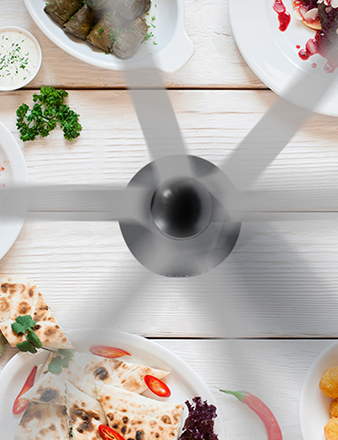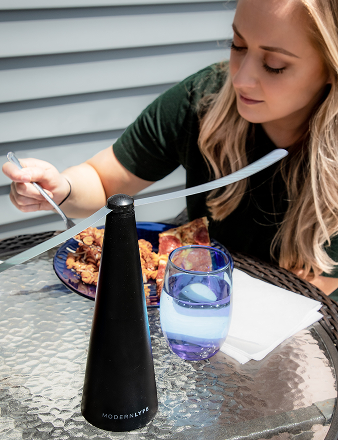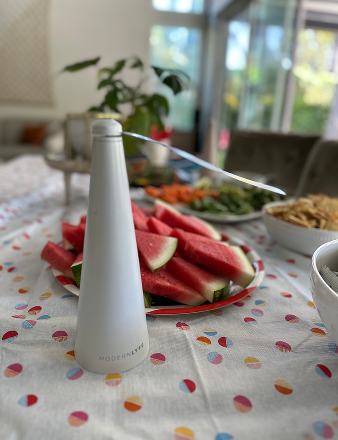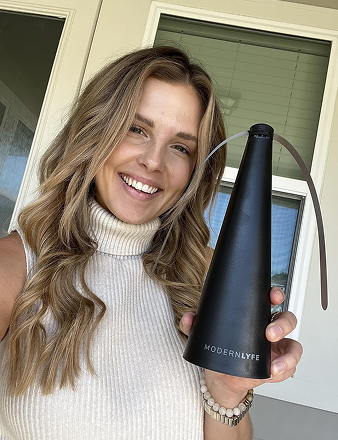Nothing ruins a backyard barbecue faster than a swarm of mosquitoes. You don't have to douse yourself in chemicals to fight them off. An outdoor mosquito fan is a simple, effective way to create a bug-free bubble using a steady stream of air to physically block pests from crashing your party. It's a safe, family-friendly way to take back your patio.
Why a Fan is Your Best Friend Outdoors
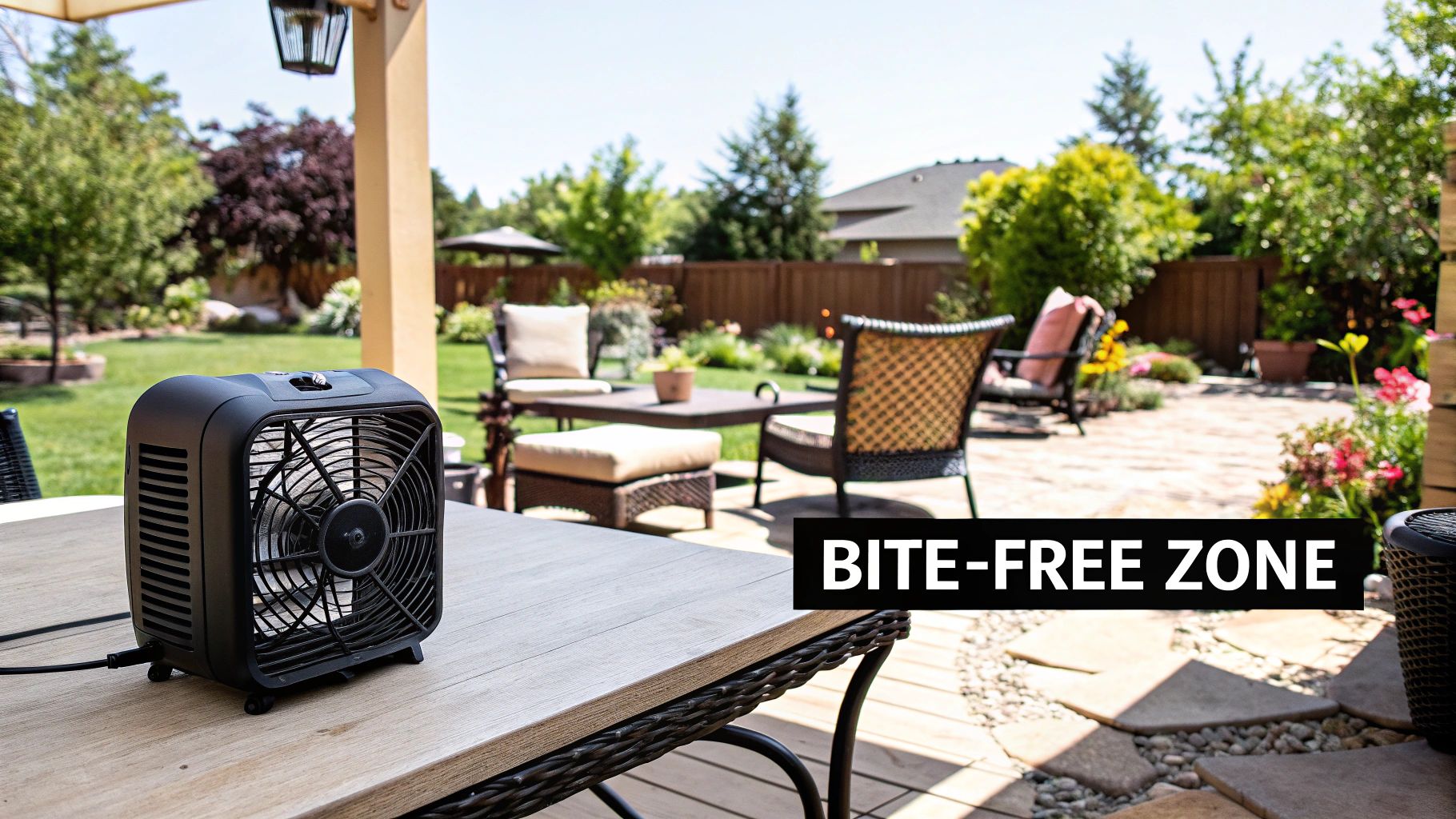
Trying to walk straight in a windstorm is tough. That's what a mosquito faces when it flies into a fan's airstream. Mosquitoes are weak flyers, and even a light breeze sends them off course. An outdoor mosquito fan uses this simple fact to its advantage.
Instead of relying on chemical sprays or noisy zappers, a fan works on pure physics. The airflow blows mosquitoes away, making it impossible for them to land and bite.
But that's only half the story. The breeze also scatters the carbon dioxide (CO2) you exhale. That’s a big deal, because CO2 is the main homing beacon mosquitoes use to find you. By dispersing your scent, the fan makes you invisible to them. This one-two punch is what makes fans so effective.
The Rise of Smarter Mosquito Solutions
People are catching on. The demand for safer, chemical-free ways to control mosquitoes is booming. The overall mosquito killer market, which includes devices like outdoor mosquito fans, was recently valued at USD 2.76 billion. Experts predict it could climb to an estimated USD 6.31 billion as more people focus on preventing bug-borne illnesses without harsh chemicals. You can learn more about the growth of the mosquito control market and its public health implications.
This trend shows a clear shift. Families want reliable solutions that keep them safe while enjoying their backyards. A powerful outdoor fan fits this modern approach, giving you immediate relief and peace of mind.
Here’s why it’s a great chemical-free option:
- Safety First: No harsh chemicals means it’s safe around kids, pets, and food.
- Works Instantly: The protective zone is created the moment you turn it on.
- Bonus Cooling: On a hot day, the cooling breeze is a welcome bonus.
The Science of How Airflow Stops Mosquitoes
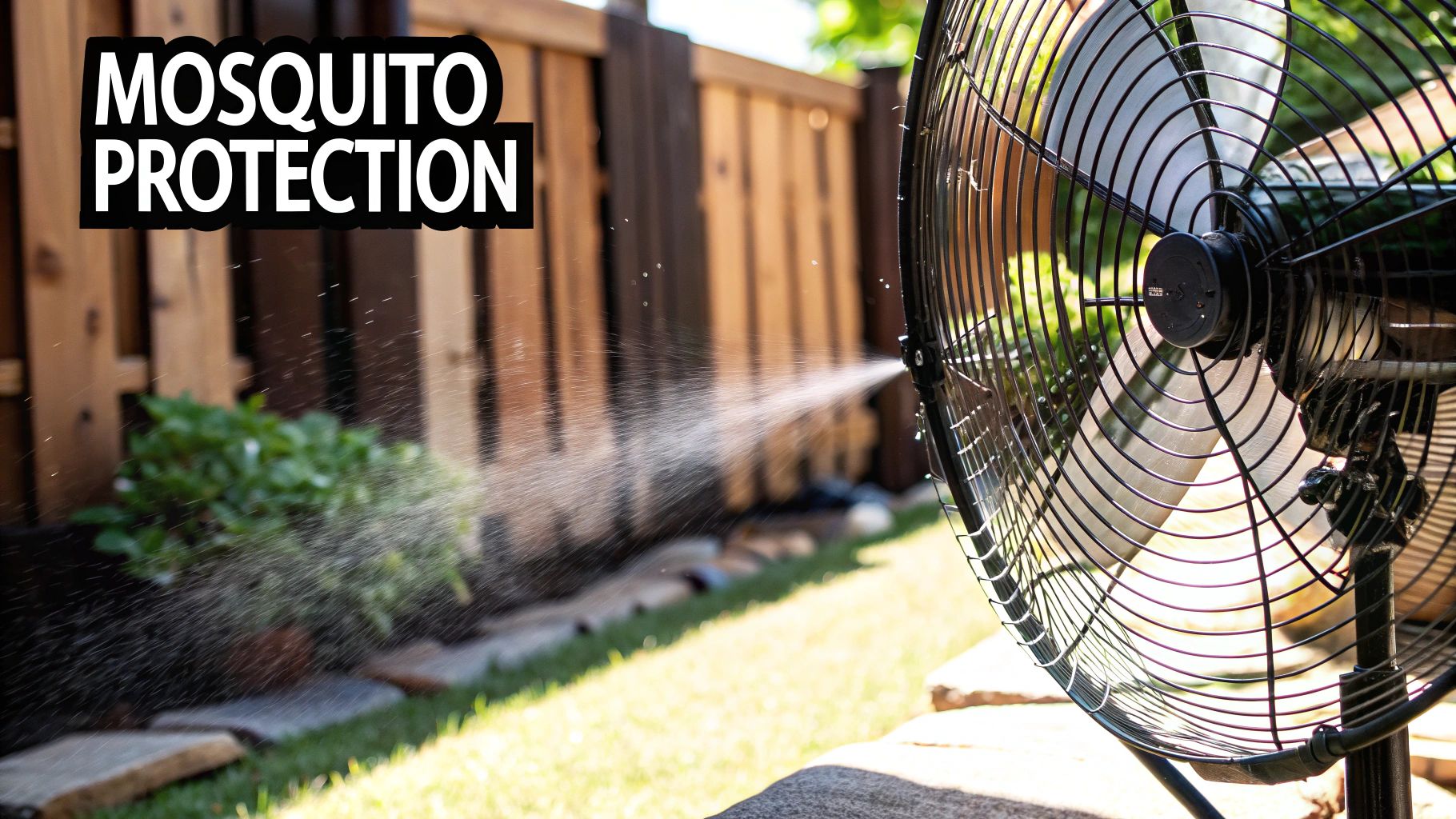
It sounds too simple, right? A fan to keep mosquitoes away? But the effectiveness of an outdoor mosquito fan is rooted in solid science. These devices don’t need chemicals because they attack mosquitoes on two fronts they can’t overcome.
First, there's the sheer force of the wind.
Mosquitoes Are Terrible Fliers
Let’s be clear: mosquitoes are pathetic fliers. They're lightweight and clumsy, making them highly vulnerable to air movement. Think of trying to fly a tiny paper airplane in a windstorm—it’s not going to happen.
An outdoor fan creates this exact chaos. A gentle breeze of just 1 to 2 MPH is enough to send a mosquito tumbling, preventing it from making a controlled landing. The constant airflow is a physical barrier they are too weak to cross.
Hiding Your Scent in Plain Sight
The second, more critical way a fan works is by scrambling a mosquito's senses. Mosquitoes don't hunt with their eyes; they track you like tiny, winged bloodhounds using their sense of smell.
With every breath, you exhale a plume of carbon dioxide (CO2), which acts like a bright neon sign that screams "buffet here!" A powerful fan grabs that CO2 cloud and scatters it.
By constantly diluting and dispersing your scent, the fan makes it impossible for mosquitoes to lock onto your location. It's like you've deployed a sensory smokescreen, making you effectively invisible.
By creating a physical barrier with wind and a sensory smokescreen for your scent, an outdoor mosquito fan delivers a powerful one-two punch that turns your deck or patio into a no-fly zone.
A Deceptively Simple Solution
This dual-action strategy—overpowering their weak wings and confusing their keen sense of smell—is what makes fans so effective. You're not just swatting mosquitoes away; you're actively hiding from them in plain sight.
This principle doesn't just work on mosquitoes. If you're curious about how this technology holds up against house flies, our guide on if fly fans really work has the answer.
Once you grasp these two core ideas, you'll see why an outdoor mosquito fan is much more than a cooling device. It's a strategic tool for reclaiming your backyard from biting insects.
What to Look For in an Effective Mosquito Fan
When you're ready to buy an outdoor mosquito fan, knowing what features matter will make all the difference. Not all fans are created equal. The right mix of power, coverage, and clever extras is what turns your patio from a mosquito buffet into a bug-free zone.
The number one thing to understand is CFM, or Cubic Feet per Minute. Think of CFM as the fan's horsepower. It measures how much air the fan can push in one minute, which directly impacts its ability to blow mosquitoes away and scatter your scent. A higher CFM creates a stronger, more reliable barrier.
Airflow and Coverage Are Everything
A powerful motor is a great start, but how that power is used is just as important. If you have a large patio where people are spread out, an oscillating fan is non-negotiable.
Oscillation makes the fan sweep back and forth, spreading the protective breeze over a much larger area. Without it, you’re just creating a narrow tunnel of air, leaving anyone outside that direct line vulnerable. This single feature dramatically boosts the fan's protective range.
The image below breaks down the difference the right fan can make in bite reduction, coverage, and overall usability.
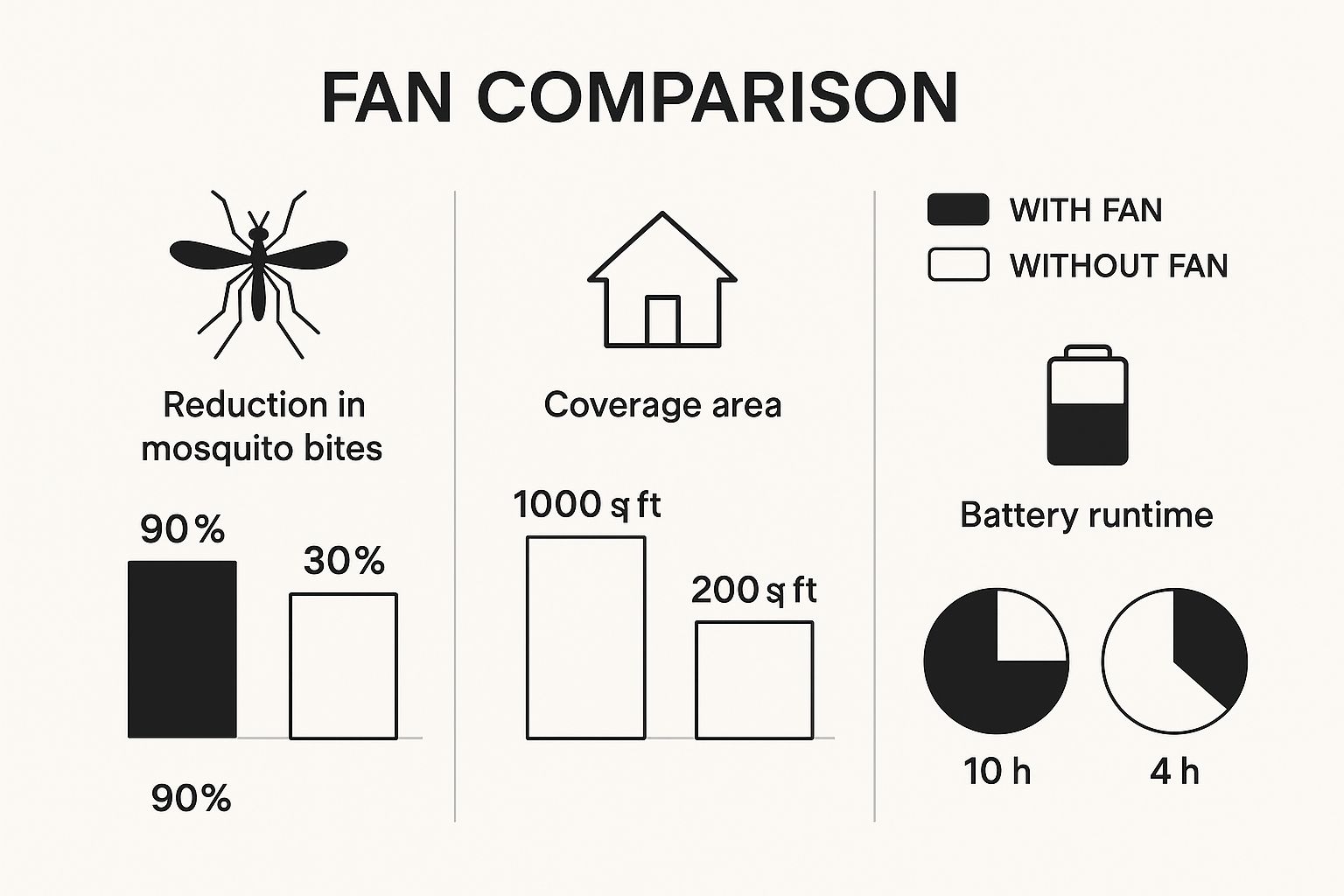
As you can see, a purpose-built fan does far more than just move air—it offers wider protection and runs for hours.
Going Beyond the Basics: Advanced Features
Today’s mosquito fans often come with built-in extras that upgrade their performance and your comfort. These aren't just gimmicks; they can turn a simple fan into an all-in-one outdoor powerhouse.
- Misting Functions: Many top-tier models include a misting system that hooks up to your garden hose. This feature releases a fine mist that can cool the air by as much as 20 degrees Fahrenheit. You get a cool breeze and bug protection all at once.
- Repellent Diffusers: Look for fans with compartments for repellent inserts. As the fan runs, it spreads the repellent through the air, creating a chemical shield that complements the physical one.
- Integrated UV Lights: Some fans combine airflow with a UV light to attract insects. Once bugs are lured in, they're either trapped or zapped, adding another layer of pest control.
To help you decide, here's a quick comparison of the most important features.
Comparing Key Features of Outdoor Mosquito Fans
This table compares essential features to help you choose the right type of fan based on your outdoor space and needs.
| Feature | What It Does | Best For | Consideration |
|---|---|---|---|
| High CFM | Measures the fan's raw power to move air and disrupt mosquito flight. | Any outdoor area where strong, consistent airflow is needed. | Higher CFM often means more noise and energy consumption. |
| Oscillation | Sweeps the airflow back and forth to cover a wider area. | Large patios, decks, and open spaces with multiple seating areas. | A stationary fan is fine for a small, single-person space. |
| Misting Function | Releases a fine mist to cool the air significantly. | Hot, dry climates where cooling is as important as bug control. | Requires a connection to a water source (garden hose). |
| Repellent Diffuser | Circulates a scent-based repellent for an added layer of chemical protection. | Areas with heavy mosquito populations where airflow alone isn't enough. | You'll need to periodically replace the repellent inserts. |
Choosing a fan with the right combination of these features gives you the best shot at reclaiming your outdoor space.
Don't Forget the Practical Stuff
Finally, think about the details that make a fan easy and safe to use. Look for models with an adjustable height and a tilting head. This lets you aim the airflow exactly where you need it most—around your ankles and legs, where mosquitoes love to bite.
Portability is another big one. A fan with sturdy wheels is much easier to move and store. And while these fans are great for mosquitoes, smaller, targeted fans have their place too. If you're hosting a dinner party, you might be interested in our guide on using fly fans for tables.
By balancing power with practical touches, you’ll find a fan that’s not just effective, but a perfect fit for how you live.
Choosing the Right Fan Style for Your Space
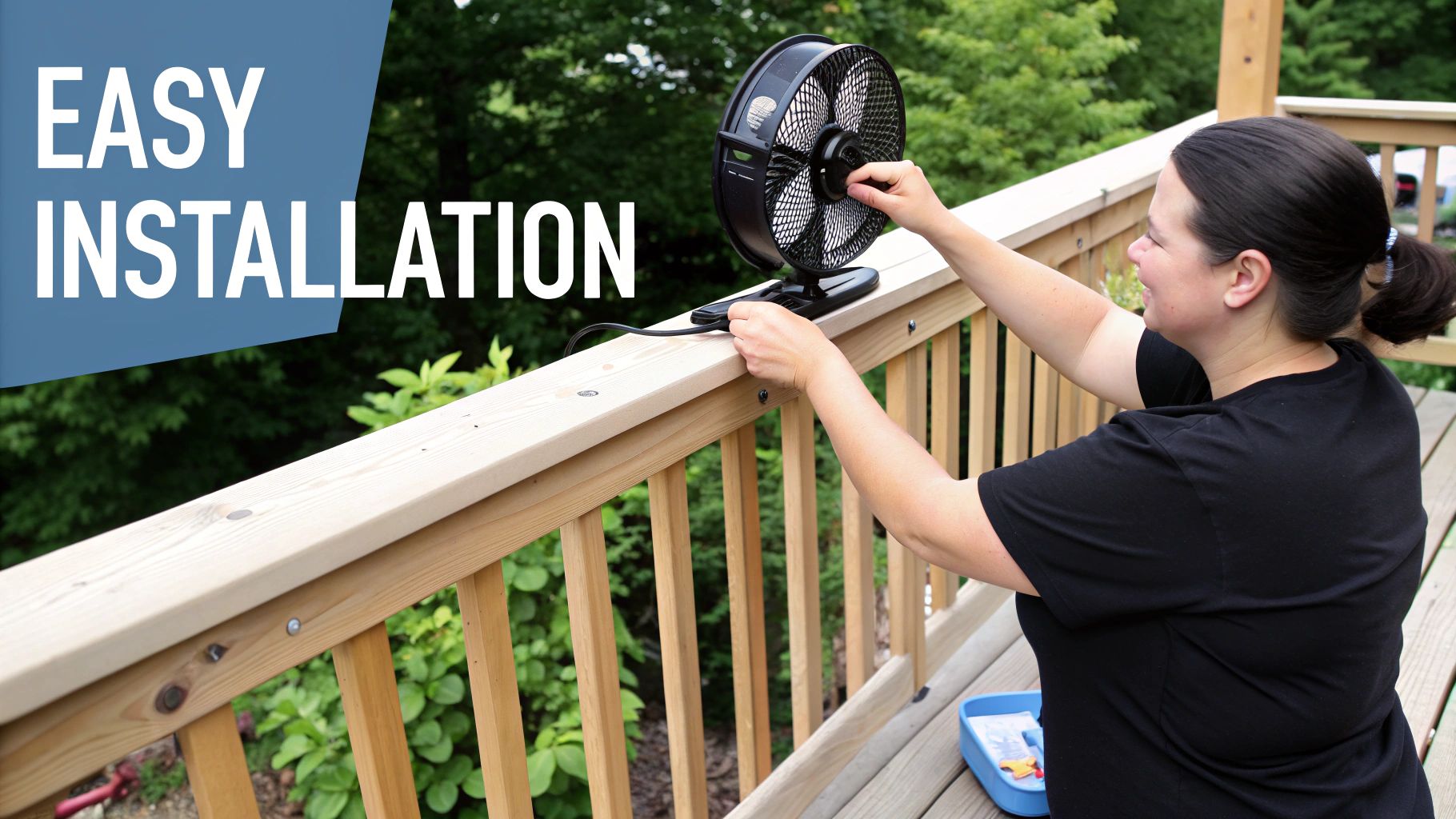
Knowing the key features is a great start, but the real magic is matching the right style of fan to your space. The fan you need for a tiny balcony is completely different from one meant to cover a huge deck. Getting this choice right ensures your money is working as hard as possible to keep your space bug-free.
Let's walk through the most common styles to find the best fit for your outdoor area.
Standing Pedestal Fans for Ultimate Versatility
Standing pedestal fans are the most popular choice for a reason—they're incredibly flexible. These fans offer a great mix of power and portability, making them perfect for almost anywhere, from a medium-sized patio to a big backyard.
The best part is their mobility. You can move them to create a protective breeze exactly where your guests are sitting. Their adjustable height and tilt are also key, letting you aim the airflow down at ankle and leg level, where mosquitos thrive. Just look for a model with a heavy, weighted base so it won't topple over.
- Best For: Decks, patios, and poolside areas where you need adaptable coverage.
- Coverage Area: Typically effective for spaces between 150 to 400 square feet, depending on the fan's power (CFM).
- Power Needs: Most just need a standard outdoor-rated electrical outlet.
Wall-Mounted Fans for Saving Space
Have a covered porch, narrow deck, or a small patio where every square foot counts? A wall-mounted fan is a fantastic space-saving solution. By lifting the fan off the ground, you clear up floor space while still getting powerful, directed airflow.
These are a permanent installation, so think carefully about placement. Mounting one in a corner and letting it oscillate across your seating area is usually the best strategy. Once it's up, it’s a true set-it-and-forget-it fix for any covered outdoor room.
Choosing the right fan style is like picking the right tool for a job. A wall-mounted fan in a small, covered porch provides constant, targeted protection without cluttering your limited space, making it a smart, permanent fixture.
Tabletop Fans for Intimate Settings
For a smaller, cozier spot—like a bistro table or a seating area for two—a compact tabletop fan is the perfect fit. They aren't as powerful as larger models, but they're more than enough to create a personal, bug-free bubble.
They’re also great for putting directly on a dining table to keep pests away from your food. Many of these models are battery-operated, giving you total portability. We're also seeing innovations like devices that combine a light with repellent or even solar-powered options. You can read more about advancements in mosquito repellent technology to see what's coming next.
Getting the Most Out of Your Mosquito Fan
A great outdoor mosquito fan is only half the battle—how you use it is the secret to reclaiming your patio. A few smart adjustments can turn a simple fan into your personal mosquito defense shield.
Placement is crucial. Mosquitoes are weak fliers, so your goal is to create a breezy barrier they can't cross. Always put your fan upwind from where you're sitting. This way, the breeze washes over your seating area, pushing pests away before they get close.
Go for the Ankles
Think about where mosquitoes always seem to get you: your ankles and lower legs. It's not your imagination. Many types, like the pesky Aedes aegypti mosquitoes, fly low to the ground.
Don't just point the fan straight ahead; aim it down. Tilt the fan head so the airflow sweeps across the lower part of your chairs and lounge area. This simple change creates a powerful "no-fly zone" right where ankle-biters hang out.
Look Beyond the Breeze
Your fan is your frontline defense, but don't forget to manage the battlefield. Mosquitoes need standing water to breed, and it doesn't take much. A bottle cap full is all they need.
Routinely check for and empty any stagnant water in clogged gutters, flowerpot saucers, birdbaths, or forgotten toys.
Think of it this way: The fan stops the mosquitoes that are here now. Getting rid of standing water stops the next generation from ever showing up.
Removing their breeding grounds is a huge step in any pest control strategy. This works for more than just mosquitoes. For other tips, check out our guide on how to keep flies away outside.
Today’s best fans are designed with real-world use in mind. People want effective, quiet, and energy-efficient models that don't disrupt their outdoor peace. This push for better products has led to innovations like whisper-quiet motors and solar-powered options, making it easier than ever to find a fan that works for your lifestyle.
Answering Your Questions About Outdoor Mosquito Fans
It's normal to have questions before you commit. Let's tackle the most common ones about adding a mosquito fan to your outdoor setup.
How Loud Are These Fans, Really?
This is a big one—nobody wants a jet engine drowning out their conversation. The noise level depends on the model, but most fans designed for patios are surprisingly quiet. Look for the decibel (dB) rating in the product specs.
A powerful, high-velocity fan will make more noise than a small tabletop model. But many of the best options are engineered to produce little more than a gentle hum you'll barely notice.
Can't I Just Use My Regular Indoor Fan Outside?
I get this question all the time, and the answer is a hard no. It might seem like a good quick fix, but it's a major safety risk.
Indoor fans aren't built for the outdoors. They lack weather-resistant materials and sealed components needed to handle moisture and humidity. An outdoor-rated fan has a UL "wet rating," certifying it's safe for damp environments. Using an indoor fan outside can lead to electrical shorts or even a fire, not to mention it will likely rust and fall apart.
How Much Will This Add to My Electric Bill?
You can relax on this one. Most outdoor mosquito fans are light on electricity, typically using about the same power as a standard indoor fan.
Of course, a model with all the bells and whistles—like a misting system or UV lights—will draw more power. The best way to know for sure is to check the wattage listed in the product details before you buy. It will give you a clear picture of its energy use.
Ready to reclaim your backyard? Take a look at the lineup of stylish and powerful insect control solutions from MODERN LYFE to create your own mosquito-free zone. Find the perfect fan for your space at https://modernlyfe.com.

